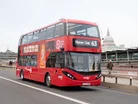Driving London’s Green Future: Route 63 Goes Fully Electric

Route 63, which runs between Honor Oak and King's Cross, is one of the city’s busiest routes, serving thousands of commuters daily.
Transport UK London Bus (TULB) and Siemens have now fully electrified the route, paving the way for a greener future.
London has been at the forefront of sustainable urban development and the electrification of the Route 63 bus service is an important leap in the city's environmental strategy.
With its focus on reducing emissions and improving air quality, this move reflects a growing trend in public transport innovation.
Scope 3 emissions reduction
The environmental impact of electrifying London’s Route 63 doesn't just stop with the buses themselves.
The electrification of Route 63 can be mapped to several Scope 3 categories.
Category 11: Use of sold products
The electric buses sold to Transport UK London Bus are in use throughout their operational lifetime, with significantly lower emissions than traditional diesel vehicles.
Although they are powered by electricity, there are still emissions to account for from the energy used to charge these buses. The project addresses this by ensuring that London's grid becomes increasingly powered by renewable energy.
Category 4: Upstream transportation and distribution
Another key consideration is the emissions associated with delivering these buses to the city.
Manufacturing partner Alexander Dennis was responsible for transporting the fleet to London, with upstream transportation emissions calculated as part of the wider carbon footprint of this electrification process.
Category 2: Capital goods
Purchasing the buses themselves, as well as upgrading depot infrastructure and installing new charging facilities, also falls under Scope 3.
These capital investments are crucial to ensuring that the fleet has the necessary infrastructure to remain operational and efficient throughout the day.
London's zero-emission bus vision
Transport for London (TfL) has committed to a zero-emission bus fleet by 2034, aiming to make public transport as green as possible.
Mayor Sadiq Khan has placed sustainability at the heart of London’s transportation agenda, with Route 63 serving as a pilot project for future developments.
"This transition is key to cleaning up London’s air and achieving net-zero carbon by 2030," Sadiq Khan said.
"Our zero-emission bus fleet is setting a standard for cities around the world."
The scale of this ambition is clear - London already operates more than 1,600 zero-emission buses, making it home to one of Europe’s largest electric bus fleets.
The full electrification of Route 63 serves as a vital contribution to this target, improving air quality and cutting the route's carbon footprint.
Category 7: Employee commuting
The introduction of electric buses on Route 63 also has indirect benefits for employees. Many workers along this busy route rely on the service for their daily commute.
Cleaner buses mean better air quality and a more environmentally friendly way of getting to work, which may influence broader commuting habits and further reduce the city’s overall emissions.
Siemens and climate tech partnerships
The success of the Route 63 electrification was made possible through a partnership with Siemens and its financing arm, Siemens Financial Services (SFS). The end-to-end solution they provided included everything from bus charging infrastructure to grid connection at the Walworth depot.
John Eardley, Managing Director at TULB, noted: "With the strength of financial support through Siemens Financial Services, we were able to build our electric fleet while minimising capital expenditure."
Siemens’ scalable charging solutions are crucial to keeping the fleet powered throughout the day. With interconnected, IoT-driven charging technology, Siemens is playing a vital role in powering London’s eMobility revolution.
This fits into a broader strategy to create smart, efficient transportation systems that work in harmony with the city’s energy needs.
The future of electric buses
The International Energy Agency (IEA) predicts that electric buses will play a pivotal role in reducing global emissions.
In 2023 alone, 50,000 electric buses were sold worldwide and the market is expected to grow substantially by 2028.
"Electric vehicles are one of the driving forces in the new global energy economy," IEA Executive Director Fatih Birol concludes.
"By 2030, EVs will avoid the need for at least five million barrels a day of oil. Cars are just the first wave: electric buses and trucks will follow soon."
The electrification of Route 63 is more than a local success story - it is part of a global push towards greener cities, cleaner air and lower carbon footprints.
By addressing emissions from multiple angles, from bus operation to employee commuting and upstream distribution, London’s bus electrification is a comprehensive approach to sustainability that will inspire similar initiatives around the world.
Receive the next edition of Scope 3 Magazine by signing up for our newsletter.
As part of this portfolio, make sure you check out Procurement Magazine and also sign up to our global conference series – Procurement & Supply Chain LIVE.
Also check out our sister brand, Sustainability Magazine and sign up to its global conference series – Sustainability LIVE.
Scope 3 Magazine is a BizClik brand.
- Global Scope 3 Emissions: A Corporate Sustainability ShiftScope 1 2 and 3
- IKEA Preowned Launches to Tackle Scope 3 EmissionsCircular Economy
- Ascend Elements' Lithium Recovery Tackles Scope 3 EmissionsCircular Economy
- Boeing & CSIRO's Collaboration to Tackle Scope 3 EmissionsScope 1 2 and 3
Featured Articles
Estonia, Latvia and Lithuania join the European grid, cutting ties with Russian energy, a move that boosts regional security and sustainability
TÜV SÜD: New battery regulations bring Scope 3 hurdles, requiring sustainable sourcing, digital traceability and design changes increasing compliance
Nissan is scaling up its use of green steel, reducing CO2 emissions in its supply chain as part of its goal to achieve carbon neutrality by 2050

